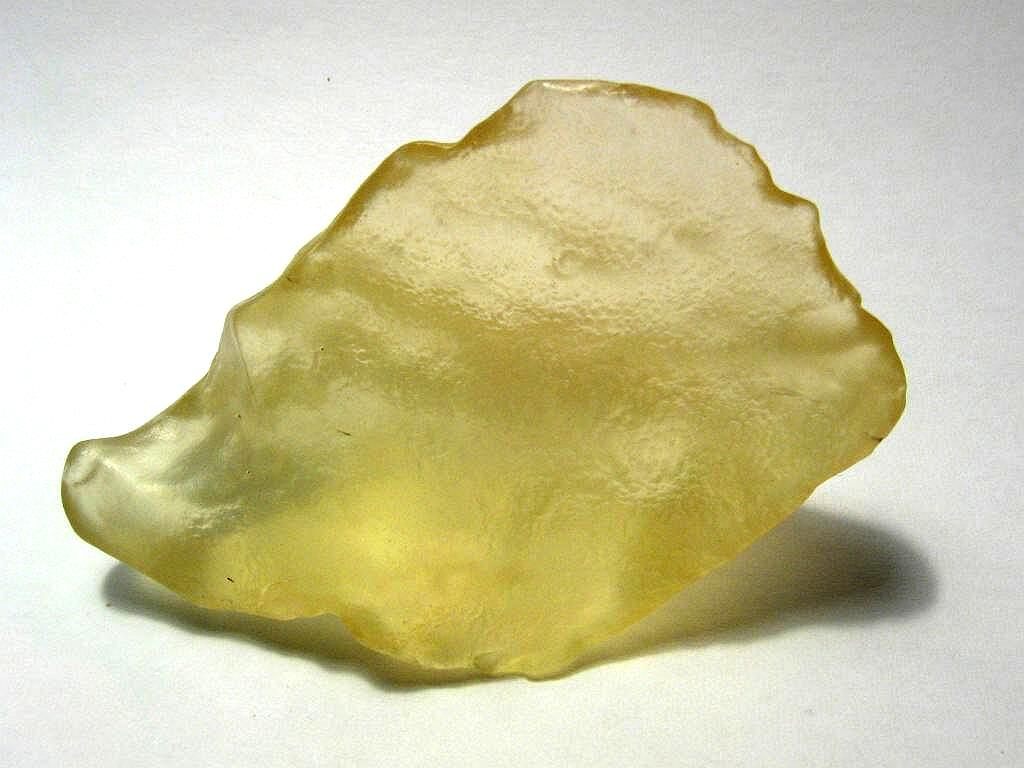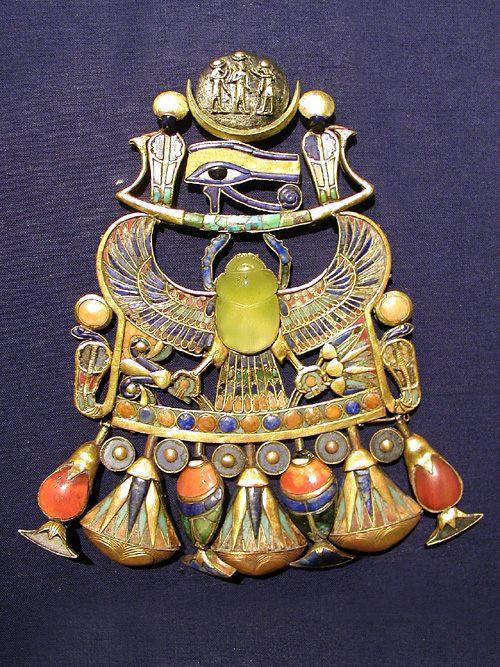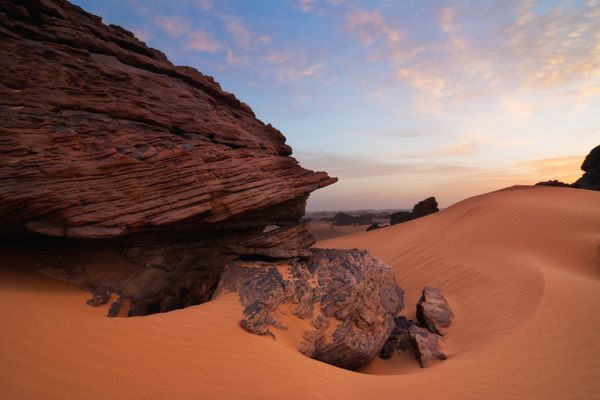How a Meteor Crash Formed Stunning Desert Glass
It was precious enough for King Tut’s tomb.

Let’s go back in time roughly, oh, 20 million years. It’s the Miocene era, which formally began 3.03 million years prior, and India and Asia are just beginning to collide and form the impressive mountain ranges we know today. Kelp forests and brown algae are appearing and diversifying oceans at rapid rates; in Europe and Africa, around 100 different species of early apes are monkeying around.
With this as the backdrop, let’s zoom in on North Africa specifically. Libya, bordered by the Mediterranean Sea on the north and Egypt to the east, is about to experience a geological miracle. Unbeknown to the colliding mountains and swinging apes of the Miocene, the 420,000 square miles that make up the Libyan desert (which is part of the Sahara) would soon be caramelized into shards of foggy green glass. This rare and precious material, known as Libyan Desert Glass, was found in King Tutankhamun’s burial tomb millions of years later.

Libyan Desert Glass’ value comes from the miraculousness of its origin story. As Dr. Jane Cook, chief scientist at The Corning Museum of Glass in Corning, New York, explains, “glass happens when just the right ingredients are heated up and cooled down quickly.” But in the case of Libyan Desert Glass, the series of events was much more elaborate. “About 20 million years ago, either a meteor impact or atmospheric explosion got to the desert part of the lower atmosphere, heated it up and fragmented and exploded,” she says. “It dumped a huge amount of heat, like in thousands of Fahrenheit degrees, into that portion of the desert, which was a relatively pure deposit of quartz sand. And it brought it up hot enough that it was able to liquefy for a short period of time.” When this liquefied quartz cooled down, desert glass was formed. Cook adds: “Because it was almost pure silica it was able to solidify without crystallizing,” making it glass instead of geological crystal structures.
When British archaeologist Howard Carter began searching through King Tut’s treasure chests in 1922, he found a decorative breastplate depicting the Sun God Ra. Housed in the center of this armor sits a chartreuse scarab: a beetle symbol, usually cut from gemstones, that ancient Egyptians held sacred. This particular 18th-Dynasty scarab was carved from the rare and precious Libyan Desert Glass, as confirmed by Italian mineralogist Vincenzo de Michele in 1998.

Though other meteor impact glasses do exist, in contrast to the more common man-made glass, Libyan Desert Glass is widely regarded as being “the most spectacular,” says Cook. Considering glass was formally “invented” in 1500 B.C., it’s no surprise that the 20-million-year-old translucent matter was considered precious enough to be placed at the center of King Tut’s breastplate.
Dr. Katherine Larson, assistant curator of ancient glass at Corning, studies the cultural importance of the material. “We identify Libyan Desert Glass as glass based on the material properties of it, but in the Ancient Egyptian mind, the glass and the stone are really closely linked,” she says. “In fact, the Ancient Egyptian word we have for glass, that’s preserved in hieroglyphic texts of this period, actually means ‘stone that pours.’ ”

At the time King Tut’s breastplate was made, Libyan Desert Glass was probably not seen as that different from other naturally occurring semi-precious stones, like amethyst, lapis lazuli, or quartz. What we now understand to be an impactite (glass formed from impact), would have been a generally beautiful and valuable stone from the ancient point of view—but still with a high prestige factor. “The general index we use for preciousness is that we equate it with rarity, and that’s probably true in the ancient world as well,” Larson says. “So the more resources that it takes to acquire something, the further it comes from, [or] the more exotic it is, those are all things that can contribute to [the material] being considered precious or rare.” Though unidentified at the time, this milky yellow-green glass birthed from the “Great Sand Sea” would have had an even higher value rating because it wasn’t harvested or used as a trade good, whereas most man-made glasses were. Plus, Larson says, “in this case, it is a pretty rare type of stone, and it would’ve come from relatively far away, so that certainly contributed to its preciousness. And then there’s the aesthetic properties of it as well. There’s an attractiveness to it.”
When that fateful meteor crashed into the Libyan desert all those millions of years ago, whatever contaminants dissolved into the silica’s liquid state ended up affecting the color and opacity of the solid Libyan Desert Glass. Specimens range from a cloudy dark brown to a stunningly luminous lemon yellow, and are still being found today. “[The Libyan desert is] a large area, hundreds of square miles perhaps, so that explosion was gigantic,” Cook says. “And it glassified—vitrified would be the technical term—a huge area in a relatively remote and underpopulated part of the [country].” All these years later, people are still digging up fragments of the glass that graced the most famous Egyptian pharaoh’s tomb.
This story originally ran on November 6, 2018.











Follow us on Twitter to get the latest on the world's hidden wonders.
Like us on Facebook to get the latest on the world's hidden wonders.
Follow us on Twitter Like us on Facebook